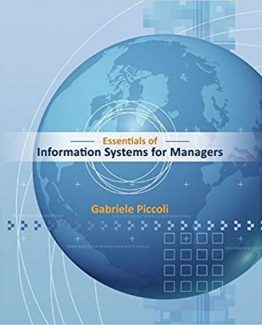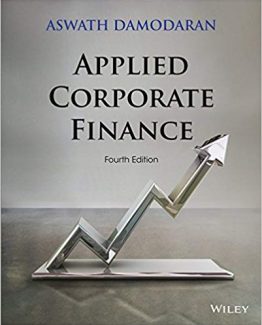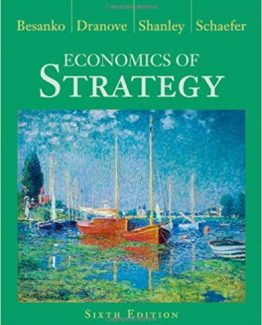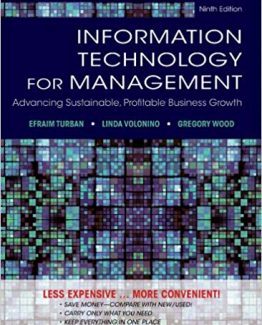Business Writing Today: A Practical Guide 4th Edition by Natalie Canavor, ISBN-13: 978-1071854068
[PDF eBook eTextbook] – Available Instantly
- Publisher: SAGE Publications, Inc; Fourth edition (September 28, 2022)
- Language: English
- ISBN-10: 1071854062
- ISBN-13: 978-1071854068
Business Writing Today: A Practical Guide, Fourth Edition prepares students to succeed in the business world by giving them the tools they need to write powerfully, no matter the challenge. In her highly-practical text, author Natalie Canavor shares step-by-step guidance and tips for success to help students write more clearly and strategically. Readers will learn what to say and how to say it in any medium from tweets and emails to proposals and formal reports. Every technique comes with concrete examples and practice opportunities, helping students transfer their writing skills to the workplace.
Table of Contents:
Preface
A Note to Instructors
Acknowledgments
About the Author
Part I How to Communicate in Writing
Chapter 1 Business Writing Today—and You
Writing and Your Career, Now and Tomorrow
How Employers Value Writing
Applying Good Writing Principles Across Platforms
Communicating Your Own Value
How to Choose the Right Communication Platform
Don’t Choose Writing When……
Do Depend on Writing When…
Using the Best Channel for Written Messages
How to Use This Book
Summary Checklist: Planning Your Business Writing Experience
Practice Opportunities
Chapter 2 How to Build Successful Messages
Planning Successful Messages Step by Step
Step 1: Know Your Immediate and Long-Range Goals
Put Bottom Line on Top
Define Goals to Narrow Your Vision
Put Your Goals Analysis to Work
Step 2: Characterizing Your Audiences and Understanding Their Perspective
Observe People to Predict Their Response
Recognizing Personal Filters
Practice Reading Between the Lines
Bridging Personal and Generational Differences
Understanding Your Generations
Generation Z: Born 1995 or Later
Millennial Generation (Generation Y): Born 1981–1995
Generation X: Born 1965–1980
Baby Boomers: Born 1946–1964
Communicating Cross-Generation
Tap Into Your Intuition
Putting Your Insights to Work
Building Relationships in a Diverse World
Writing to People You’ve Never Met
Inventing an Audience
Assessing Corporate Culture
Writing to Groups
Gatekeepers and “Serial Audiences”
Messages to the Universe: Digital Media
Summary Checklist: Best Practices for Developing Effective Messages
Practice Opportunities
Chapter 3 Strategize Your Messaging
Your Goal: What Response Do You Want?
Your Audience: What Do You Know About Your Readers?
Your Content Points: Brainstorm to Identify Them
Structure Your Messages for Impact
THE LEAD: Don’t Bury It!
THE MIDDLE: Present Supporting Backup and Detail
THE CLOSE: End Well With Confirmation
Check Your Tone and Content
Choose How to Organize
Option 1: Create an Outline
Option 2: Tell It to Someone
Option 3: Handwrite Your Draft
Option 4: Organize Graphically
Graphic Options for All Business Writing
Use Headlines to Title a Document and Major Sections
Using Bullet Points and Numbering
Additional Graphic Techniques
Write for Small Screen Readers
The Goldilocks Principle: How Much Is Just Right?
Manage Your Written Tone
What About Emojis?
A 12-Point Tone Checklist
Writing for an Inclusive World
Avoid “Ageism”
Sidestep Sexism
Recognize Ethnic and Racial Communities Appropriately
Respect the LGBTQ+ Community
Respecting People with Disabilities
Examples: Problem-Solve With the Planning Structure
Case 1:
Drawing Important People to Campus
Three Ways To Personalize Messages
Case 2:
Asking for Opportunities
When Planning Doesn’t Help: Use Writing!
Summary Checklist: Best Practice for Strategizing Messages and Documents
Practice Opportunities
Part II Sharpen and Energize Your Writing
Chapter 4 Create the First Draft
Choose the Familiar Words of Conversation
Help Yourself to Better Words
Build Clear, Concise, Active Sentences
Build Rhythm Into Sentence Progression
Listen to Your Writing!
How Long Should Sentences Be?
Build With Action Verbs
Assemble Short, Logical Paragraphs
Deploy Strong Transitions: Words, Phrases, and Devices
Sidestep Tone Traps
Forgo Risky Humor
Recognize and Avoid Prejudicial Wording
Resist Emotional Display and Negativism
Avoid the Pompous and Pretentious
Shun the Cold and Impersonal
Summary Checklist: Best Practices for Creating a First Draft
Practice Opportunities
Chapter 5 Edit and Sharpen Your Writing
The Editing Process: Ten Principles
1. Give It the Time It Needs
2. Give It Some Space
3. Consciously Switch Roles
4. Print It Out and Use Your Red Pen
5. Edit in Successive Stages
6. Use the Read-Aloud Test
7. Use Grammar and Wording Tools
8. Find a Co-Reader
9. Proofread. Finally.
10. Track Your Changes
Practical Editing Stage 1: Review Content
Practical Editing Stage 2: Review Language and Structure
Use the Readability Index
Use the Read-Aloud Method
Commonsense Fix-It Techniques
Strip Redundancy
Substitute Short Words for Long Ones
Edit Out Wordy Phrases
Minimize Words That Create Abstract Sentences
Words Ending in –ing
Words Ending in –ion
Words Ending in –ious
Words Ending in –ed
Limit Use of Prepositions: Of, To, For, By, In, On
Limit Adjectives and Adverbs
Count Your Conjunctions: And, Or, But, For, Nor, Yet, So
Power Up Your Verbs
Sidestep Business-Speak
The Trouble With Jargon
Jargon Problem 1
Jargon Problem 2
Jargon Problem 3
The Trouble With Buzzwords
The Trouble With Idioms
The Trouble With Empty Rhetoric
The Trouble With Insensitive Language
Fixing Some Grammar Glitches
Using Commas
Using Periods
Exclamation Points
Dots and Dashes
Wandering and Ambiguous Sentences
Danglers and Misplaced Modifiers
Parallel Construction
Noun and Adjective Pileups
That Versus Who Versus Which
Who Versus Whom
It’s Versus Its
Using However
Double Negatives
Pronoun Challenges
Editing Down Long Copy
How Correct Must Business Writing Be?
Some Liberties You Can Take With Grammar
Ok: Starting Sentences With Because, And, Or, But
Ok: Ending With Prepositions and Conjunctions
Ok: Using Sentence Fragments
Finally: Proofread
Remember: Many Ways Can Work
The Fixer Takeaway: Know Yourself
Summary Checklist: Best Practice for Letters and Important Messages
Practice Opportunities
Chapter 6 Use the Techniques of Persuasion
Perspectives on Persuasion: From Greek Philosophy to Today’s Research
Start by Listening and Exercising Empathy
Create and Ask Good Questions
Use Knowledge to Build Trust
Acknowledge Other Viewpoints
Strategize Realistically
Believe It!
Build Persuasion Techniques Into Your Writing Voice
Know Your Narrative
Focus on Benefits, Not Features
Show Don’t Sell!
Create a Vision
Craft Language to Bring Your Idea to Life
Understand the Emotional Load Words Carry
Chilling Language
Conciliatory Language
Choose High-Energy Verbs
Banish Hedgy Language
Take Care With Emotionally Loaded Words
Build With Concrete, Graphic Language
Use Language to Paint Pictures
When the Story Is Yours: Finding, Shaping, Telling
How to Dig for Your Own Story
Draw on the Transformation Story Model
Tips for Writing the Story
Using Story to Reach People Emotionally
Integrate Ethos, Logos, and Pathos
Use Graphics to Support Persuasion
Some Design Fundamentals
About Typeface
Break It Up
For Proposals and Other Big Documents
Summary Checklist: Best Practices for Creating a First Draft
Practice Opportunities
Part III The Basics of Business Communication
Chapter 7 Connect With Everyday Messages
Strategize Email Messaging to Gain Your Goals
Shape Emails Based on Their Purpose
Know When Email Is Not the Right Channel
Apply the Planning Structure to Every Message
Craft Subject Lines That Entice
Use Suitable Salutations
Craft Strong Leads
Write Good Middles
Close Soundly
Communicate With a Positive and Inclusive Spirit
Smile When You Say That
Monitor for Inclusiveness
Humanize Your Messaging
Analyze Workplace Challenges Systematically
Draft 1
Draft 2
Draft 3
Version 1
Version 2
Some Email Q&A
Adapting Communication Tools for Remote Work
Email and More for Remote Workers
Compose Good Status Reports
Keep Personal Records
Handle Chat Messaging
Prepare for Video Conferencing
Summary Checklist: Best Practice for Email and Short Messaging
Practice Opportunities
Chapter 8 Writing Letters and More Formal Messages
Characteristics of Effective Letters
Format: Keep It Simple But Classic
Example: Classic Letter Format
Write Letters Specific to Each Situation
Thank-You-Very-Much Notes
Writing Effective Requests
Use Written Messages to Network and Build Connections
Asking for Informational Interviews
Sample 1
Sample 2
Use Strategies That Build Your Connections
Practice Job Application Courtesies
Writing a Rejection Message
Resigning From a Job
Delivering a Bad News Message
Framing Good Apologies: A Leadership Skill
Use the Power of Handwritten Notes
Writing Strategies for Entrepreneurs and Freelancers
Resolving a Dispute With a Supplier
Responding to Complaints
Collecting Overdue Bills
Writing for International Audiences and People With Limited Fluency
Summary Checklist: Best Practice for Letters and Important Messages
Practice Opportunities
Chapter 9 Creating Strong Business Materials
Guidelines for Writing Effective Business Documents
Handling Major Projects and Team Collaboration
Create a Comprehensive Plan of Action
Jumpstart Projects With a Folder System
Team Proactively
Collaborating to Write
Create Reports That Win Support and Add Value
Deliver the Big Picture in Project Reports
Find Your Story
Write Status Reports to Focus on Accomplishments
Writing the Executive Summary
Writing Style for Executive Summaries
Sample Executive Summary for a Report
Outline-Style Versus Narrative Executive Summary
Craven County’s Brownfields
Writing Proposals That Win Business
Working With Rigid Formats
Writing Informal, Conversation-Based Proposals
Writing Short Personal Proposals
Writing Successful Grant Applications
Grant Application Strategies
A Word on Business Plans
Writing How-To Material That Works for Readers
Summary Checklist: Best Practices for Complex Business Documents
Practice Opportunities
Part IV Writing For Online and Spoken Media
Chapter 10 Using the Digital World Strategically
The Virtual World: A Big Picture View
Leverage Your Writing Skills
Develop a Strategic Plan
Create Your Persona
Stay Consistent Across Platforms
Aim to Build Trust
Foster Relationships Creatively
Deliver Valuable Substance
Build in the Interaction
Integrate Your Online and Offline Activities
Special Characteristics of Online Writing
Plan and Write a Website That Connects With Your Audiences
Define Your Goals
Define and Profile Your Audience
Develop Message and Content Ideas
Plan Your Architecture
Choose Your Tone
Translate Print to Online Language
Introducing Kung Foe: Martial Arts Lessons Designed for Women
Middletown Women: Learn Kung Foe and Stay Safe Anywhere!
Talk to Jack! Call Today: 111-222-3333
How to Strategize a Website: Site-Building in Practice
Building a Home Page
Ted’s Small-Business Tech Support
Use Clear Wording and Icons for Navigation
About Us Page
Services/Products Page
Try Do-It-Yourself UX
The Blog: Why and How to Create Your Own
Inventory Your Strengths and Knowledge
Use Online Resources to Develop Blog Ideas
Take Trouble With Headlines and Leads
LinkedIn: Connecting With Employers, Making Contacts
Crafting Your LinkedIn Profile
Writing Tips for Online Profiles
Building Community with LinkedIn
Social Media Options: Written, Visual, Oral
Using Twitter’s Micro Magic
10 Tips for Getting the Most From Twitter
Think Global: Online Networks Live Everywhere
Keep Wording and Structure Simple
Keep Graphics Accessible and Uncluttered
Stay Conscious of Cultural Differences
Summary Checklist: Best Practices for Using Online Platforms
Practice Opportunities
Chapter 11 Leverage Your Writing Skills for Spoken and Visual Media
Writing and Using an Elevator Speech to Introduce Yourself
When You’re a New Career Builder
Developing Speeches and Oral Presentations
Presentation Planning Worksheet
Adapt Your Personal Story
For Spoken Media, Use a Sayable Writing Style
How Many Words Do You Need?
More Ways to Foster Engagement
When You Must Read a Speech
Talking Points: When You Need to Think on Your Feet
How to Use Talking Points for Interviews
Using Visuals to Support Your Messaging
Finding and Creating Your Own Visuals
Creating Effective PowerPoint Presentations
Improve Your Video Conferencing Game
Technical Tips for Smart Zooming
Planning, Scripting and Using Video
Systems to Support Planning Longer Videos
Language for Video
Consider the Limitations of Your Equipment
Introducing Yourself With Video
More Ways to Use Video
Develop Infographics to Tell Data Stories
Summary Checklist: Best Practices for Creating Presentations and Using Visuals
Practice Opportunities
Part V Into the Future
Chapter 12 Win Your Opportunities: Writing for the Hunt
Know Your Strengths and Unique Assets
Plan Your Résumé and Choose a Format to Showcase Your Capabilities
How Traditional Must Résumés Be?
Tweak the Format to Advantage
Adapt Categories and Writing Style to Your Content
Use Concise and Energetic Language
Create a Strong Summary of Qualifications
Example: A Narrative-Style Summary of Experience
Example: An Outline-Style Summary of Experience
Showcase Your Work Experience
Statement A
Statement B
Statement A
Statement B
Statement A
Statement B
Choose Content and Techniques That Show You to Advantage
Technical Specs for Résumés
Alternative Formats: Functional and Hybrid Résumés
Write Customized Cover Letters to Gain an Edge
Options for Strengthening Your Letters
Tips for Connecting With Reviewers
Adopt an Upbeat Tone
Technical Specs for Application Letters
Social Media as Your Online Résumé
Summary Checklist: Best Practices for Creating Your Application Materials
Practice Opportunities
Index
Natalie Canavor is a business writer, author, journalist and former college instructor. Throughout her successive careers as a magazine editor and public relations manager, she originated programs to help people communicate more effectively. Today she focuses on this work with practical programs for business and professional audiences, college students and writing instructors.
Natalie taught advanced writing seminars for NYU’s MS program in public relations and corporate communication for six years, and created a number of courses and workshops on strategic messaging for businesspeople, professionals and entrepreneurs.
Her byline as a journalist has appeared on hundreds of features and columns in newspapers including the New York Times and Newsday; a host of business and technical publications; and professional magazines such as Communication World and ASJA Magazine, published by the American Association of Journalists and Authors. For seven years, she wrote a column on better writing for the International Association of Business Communicators, read by 15,000 professionals worldwide.
As a national magazine editor-in-chief, Natalie created a series of successful start-ups including Today’s Filmmaker, Videography and Technical Photography. She also served as an editor of Popular Photography. As an organizational communicator, Natalie built a 14-person PR department for New York State’s largest educational agency and counseled management on communication strategy; directed print, video, and e-media; and created communications skills training programs for school leaders.
Natalie is also the author of Business Writing for Dummies, currently in its third edition, and coauthor of Workplace Genie: An Unorthodox Toolkit to Help Transform Your Work Relationships and Get the Most From Your Career, with psychotherapist Susan Dowell. She also coauthored The Truth About the New Rules of Business Writing, a popular guide for businesspeople. In the wake of a new interest in poetry, her work was recently published as part of The Song in the Room: Six Women Poets.
Natalie’s work has earned dozens of national and international awards for feature articles, video scripts, websites and publications. She served two terms as president of an International Association of Business Communicators (IABC) chapter, which recognized her as Communicator of the Year, and was a founding officer of IABC’s Heritage Region. Natalie is a member of the Author’s Guild and the American Society of Journalists and Authors.
What makes us different?
• Instant Download
• Always Competitive Pricing
• 100% Privacy
• FREE Sample Available
• 24-7 LIVE Customer Support






Reviews
There are no reviews yet.